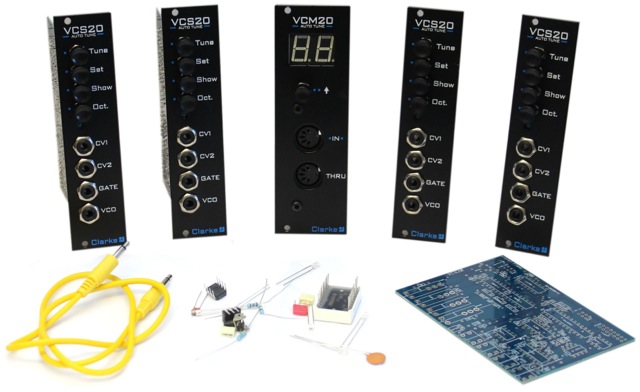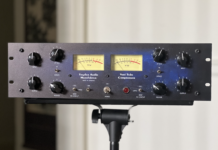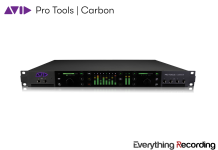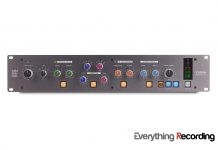The Eurorack modular system it the 500 series of the analog synth world, and Vince Clarke is the guy to tie it all together with the real world. He has created several modules for the small format system that seem to serve a unique purpose.
BROOKLYN, NY, USA: synth-pop Svengali Vince Clarke is proud to announce that he will be releasing a series of creative and utilitarian modules for the ever-present Eurorack small-format modular system under the namesake Clarke company name, designed and built to exacting standards in close collaboration with British ‘boutique’ analogue synthesiser and accessory designer/manufacturer Analogue Solutions, starting with the now-available Auto Tune — a self-contained, expandable Eurorack-compatible MIDI-to-CV converter/calibration system offering an uncomplicated solution to the problems of tuning and scaling both vintage analogue synthesisers and modern Eurorack VCO (Voltage Controlled Oscillator) modules — as of March 18…So why simultaneously sidestep into this creative and utilitarian synthesiser module manufacturing (ad)venture alongside superlative synth-pop music compositional creativity? Who better qualified to address this than the Ivor Novello Award-winning songwriter himself… hardly surprising, really, since Vince Clarke can, of course, comfortably find his way around a notable number of synthesisers, too, as attested to by the well-earned songwriting success-funded collection of analogue classics currently residing at his NYC studio, relatively recently relocated from a custom-built cabin in rural Maine to inner-city Brooklyn. But this is no millionaire’s museum piece, but rather a unique personal workspace, where each and every awe-inspiring analogue instrument included in his sizeable collection of vintage and modern synthesisers comfortably housed within regularly earns its keep on a variety of musical projects, be they synth-pop based or otherwise. “For those of you who work with synthesisers using CV and Gate, you will all be aware of the problems of calibration,” notes Vince Clarke, continuing: “Having tried many a cumbersome software-based package over the years, I wondered if there might be a neater solution — a kind of all-in-one MIDI-to-CV convertor with auto-calibration.”
And, as if by musical magic, the collaborative Clarke company concept was born. And with it the first of those creative and utilitarian modules for the ever-present Eurorack small-format modular system that is increasingly popularised (and heavily populated) by an ever-growing band of merry ‘boutique’ manufacturers now numbering hundreds worldwide… welcome into the world Clarke’s clever Auto Tune system! So, let’s learn a little more about what it is, what it does, and how, exactly, it does it…
In a nutshell, then, the Auto Tune system consists of a VCM20 master module, which can control up to 16 VCS20 slave modules, each of which provides one channel of CV (Control Voltage) and Gate. With 16-bit voltage resolution and a tune time of 10 seconds, this straightforward system can compensate for VCO alignment issues and environmental factors that cause tuning drift quite literally at the push of a button!
The VCM20 master module has an LED (Light Emitting Diode), an increment push button to select the MIDI (Musical Instrument Digital Interface) channel, and MIDI IN and MIDI THRU sockets; the VCS20 slave module has four 3.5mm jack sockets for communicating with the outside analogue synthesiser world, which is where the tuning action really gets going: CV1 connects to the synthesiser’s pitch control voltage and can be set to either V/oct (Volts per octave) or Hz/V (Hertz per Volt); CV2 is mapped to keyboard velocity — typically to control a VCF (Voltage Controlled Filter) or VCA (Voltage Controlled Amplifier); the 11 Volt GATE output can be set to either V-Trig (Voltage Triggers) or S-Trig (Switch Triggers), its use being indicated by the Gate LED; the VCO input connects to the synthesiser’s waveform or audio input and allows the VCS20 slave module to read audio frequencies during the calibration process — a square, sine, or sawtooth waveform without modulation is recommended for doing this. The oscillator output can either be split or an unused waveform connected in the case of modular system setups while with typical hardwired analogue synthesisers it’s a case of splitting the audio output or, in most cases, using the headphone output. Either way, the synthesiser needs to be set to output a single oscillator without filter or modulation with the VCA envelope set to zero attack, zero decay, full sustain, and zero release. For the most accurate calibration of the control voltage the synthesiser’s oscillator range should be set to 8’ or its initial oscillator frequency set midway.Having correctly connected everything, pressing the VCS20 slave module’s Tune button automatically tunes the analogue synthesiser, compensating for calibration errors between 0.5 and 1.5 V/oct. (During the tuning process, the Gate opens and its associated LED lights up, going out once complete.) Calibration data is duly stored — solving the problem with a neat solution! Still better, the VCS20 slave module retains the calibration data on power down — no need, necessarily, to repeat the process.Suffice to say, Vince Clarke’s canny vision of an all-in-one MIDI-to-CV convertor with auto-calibration has truly become reality with the Clarke Auto Tune system since it is possible to set the individual MIDI channel for each VCS20 slave module and see which MIDI channel a slave module is set to at any time by simply pressing its Show button. Beauty is in simple things, after all. Equally easy, the VCS20 slave module’s Oct. (octave) button transposes the incoming MIDI signal by one octave with each push, cycling around four octaves — useful if the synthesiser’s range circuit is detuned. Don’t forget, each VCS20 slave module connected can be individually set to work with V/oct or Hz/V synthesisers so a variety of older and newer analogue instruments can be calibrated and automatically tuned by the Clarke Auto Tune system. Start with a VCM20 master module and one VCS20 slave module, maybe? Then simply add more VCS20 slave modules as your analogue instrument collection grows… guaranteed to stay in tune, each and every one of them — just like Vince Clarke’s Brooklyn-based sizeable collection of vintage and modern synthesisers! Synth-pop songwriting success, sadly, cannot be guaranteed.
The Clarke Auto Tune system is priced at £189.00 GBP (plus tax and delivery) for the VCM20 master module and £189.00 GBP (plus tax and delivery) for the VCS20 slave module; all are available to order online from Analogue Solutions here: http://analoguesolutions.com/clarke/
For more detailed information, please visit the Clarke webpage here: http://www.vinceclarkemusic.com/circuits/
Watch Vince Clarke’s instructive introductory Clarke Auto Tune video here: https://vimeo.com/121670830














